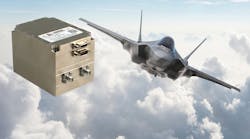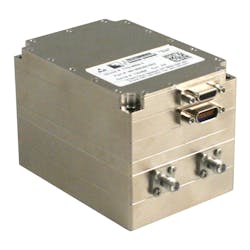Tri-Band Transmitters Ease Telemetry Application Migration to C-Band
The FCC’s auction, over the last five years, of L-band (1.4 to 1.8 GHz) and S-band (2.2 to 2.4 GHz) microwave frequencies to commercial broadband providers is driving a mandatory migration to the less-populated C-band (4.4 to 5.2 GHz) frequency by U.S. military test ranges (see figure). These test ranges historically used L/S spectrum for telemetering aircraft and missiles.
The auctions provided $2 billion of spectrum reallocation funding. It was funneled to test ranges across the country to fund the development of the ground hardware needed to support the move to C-band. The funding windfall is also helping to drive the development of new technologies, such as more modern modulation schemes.
Today, C-band offers telemetry programs a relatively un-crowded refuge from the rapid build-out of L/S-bands currently underway by the commercial sector, especially as 5G telecommunications starts to come online. What’s more, C-band, unlike the L- and S-bands, has the added advantage of worldwide use, as it’s also commonly used in Europe for telemetry applications. The transition, though, is a work in progress.
In those regions of the U.S. where the L/S bands aren’t yet greatly impacted (in comparison to some major test centers where spectrum crowding is far greater, such as in California), the FCC has allowed a continuation of their use. The agency has also provided timetable extensions to enable a smooth transition to C-band. Currently, some U.S. ranges are still using L/S, while others have made the move to C-band.
Another factor slowing the migration to C-band is the fact that nearly 90% of all missile telemetry applications are based on S-band. Not surprisingly, the ranges still have large amounts of S-band equipment inventory that they would like use before completely vacating the frequency. Also, the very large dish-shaped antennas that C-band requires are expensive and take time to install and calibrate.
Many ranges are currently in the process of installing the associated antennas and RF receivers needed to support C-band. They intend to gain experience with the new frequency in advance of the FCC ordering the complete switch over to C-band, so that any potential link issues, etc., will have already been ironed out.
Seamless Flight No Matter the Frequency
To ease and speed the transition process from L/S to C-band, vendors such as Curtiss-Wright have developed a tri-band transmitter that supports all three RF frequency ranges. Using a tri-band transmitter, an aircraft can fly seamlessly between different telemetry ranges; for example, from a range in New Mexico that still uses L-band, to a range in California that employs C-band. The pilot need only switch the frequency to enable interoperation at both ranges.
Using an Integrated Network Enhanced Telemetry (iNET) radio transceiver, a UAV frequency can be switched autonomously as the platform flies between ranges. Tri-band transmitters are designed to be backward-compatible drop-in replacements for earlier L/S devices, to speed and ease their installation.
With the funding from the spectrum auctions, the ranges, in addition to transitioning to C-band, also want to implement new technologies. Applications using two of these emerging technologies, space-time code (STC) and low-density parity check (LDPC), can also benefit from the use of tri-band transmitters.
STC, common in space environments but new to telemetry applications, is implemented in the IRIG-106 Telemetry Standard. It provides a means to mitigate interference between the upper and lower RF antennae commonly installed on experimental aircraft in development testing. When interference occurs between the two antennae (often resulting from a time delay difference), the result can be data errors on the ground.
Historically, to mitigate this interference, the pilot may attempt to change the power from one antenna to another, or roll the aircraft back and forth. STC, implemented in a tri-band transmitter, solves the interference issue with a new encoding scheme that sends different data to both antennae. The range’s ground receivers are able to differentiate between the two data streams and decide which data to use.
Another benefit of a dual-band tri-band transmitter designed to support STC results from its design, which features two variable amplifiers and two modulators. It essentially provides two transmitters stacked on top of each other.
If STC isn’t required on the aircraft, the tri-band transmitter can be used as two independent transmitters, enabling support of frequency diversity. The same data or two independent data streams can be sent over any combination of L/S or C-band. Also, if the application doesn’t need STC, or doesn’t have multipath antenna interference, a single transmitter can be used to provide the same functionality as two individual transmitters, saving size, weight, power, cabling, and time.
LDPC provides six variants of gain increases on when to extend RF data-link performance if a telemetry link is too short, or when interference like that from an aircraft engine or a launch vehicle needs to be mitigated. Curtiss-Wright has demonstrated implementation of all six LDPC gain variants on its tri-band transmitter.
Paul Cook is Director of Missile Systems at Curtiss-Wright Defense Solutions.

